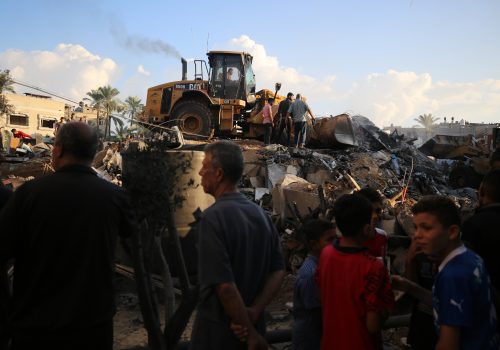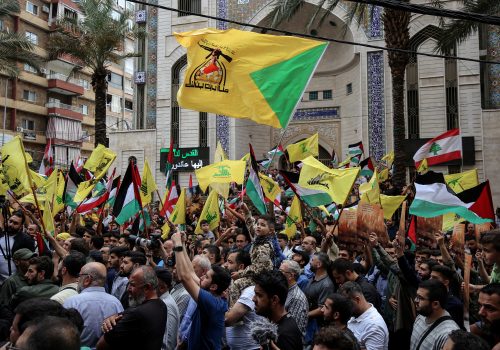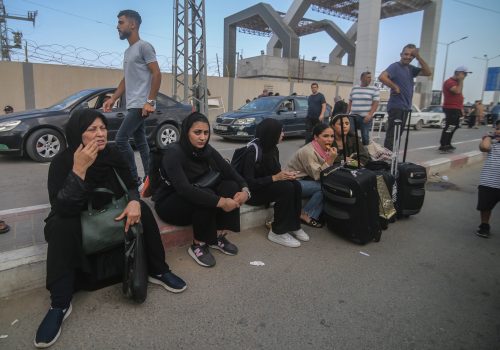Israel misread Iran’s way of war. A proper understanding could help predict Hezbollah’s next moves.
In perhaps the Israeli political echelon’s first—and, to date, highest ranking—admission of failure to preempt the October 7 Hamas-led attack on southern Israel, National Security Council chairman Tzachi Hanegbi said misunderstanding the group’s intentions was “my mistake, first and foremost.” Hanegbi explained that Israel “believed Hamas internalized the lessons” of Operation Guardian of the Walls “when it was dealt a heavy blow” in 2021.
As proof, he pointed to Hamas’s seeming indifference to Palestinian Islamic Jihad’s (PIJ) “pleas for help”—as he put it—when PIJ clashed with Israel in August 2022 and May of this year. “Hamas decided to remain outside the battle,” Hanegbi said. Though accurate on a technical level, Israel’s analysis of Hamas’s intentions, as reflected in Hanegbi’s statement, demonstrates a fundamental failure in understanding how Iran and its proxy forces operate, cooperate, and make war.
Iran’s proxies have long ceased to work as geographically contained entities or in isolation. Particularly with the onset of the Syrian civil war, Tehran has worked on integrating its various extensions and proxies into a mutually reinforcing and symbiotic regional alliance—a true “Axis of Resistance.” This also applies to Hamas, both within the Palestinian Territories and outside them.
Inside the Gaza Strip, the group has operated as a first among equals among the twelve-member Joint Operations Room of the Palestinian Resistance Factions since 2018, an umbrella organization coordinating the activities of all Gaza-based terror groups. More broadly, Hamas and this entire Gaza-based umbrella organization have become integrated into the regional, Iranian-led Axis of Resistance.
It is critical to understand how these forces symbiotically operate. First, to the extent that this is possible, they have set aside their differences. This was most evident with Hamas in the Syrian civil war. At the conflict’s outset, the group’s Sunni loyalties led it to oppose Bashar al-Assad’s brutal assault against his people. However, in time—circa mid-2017—Hamas became more agnostic on the Syrian conflict, neither fighting to save Assad like Iran’s other extensions nor commenting on the war at all. Indeed, from 2017 until Hamas reconciled with Damascus in 2022, the Syrian civil war did not exist as far as the group was concerned. The Axis of Resistance had decided to set aside these differences, which were dividing their forces and weakening them through infighting, and focus on their greater, shared goals: eroding American regional influence and the eventual destruction of the State of Israel.
The Axis of Resistance’s constituent organizations also cooperate militarily. In countries like Syria, they fought alongside each other. But their cooperation can take different forms, like sharing intelligence, military knowledge, and experience, joint planning and coordination, and, at times, the more experienced groups loaning forces or attaching advisors to more junior counterparts.
The final point relates to the tension between the desire of the Axis of Resistance to ceaselessly pursue its larger objectives and the constraints of reality that may prevent any of its constituent forces from acting freely at any given time. In a practical sense, this has meant that the Axis groups will figuratively pick up the slack for each other.
This is most relevant to Hanegbi’s observation that Hamas abstained from involvement in the two recent rounds of fighting between PIJ and Israel. Hamas had not been permanently nor temporarily deterred by Israel. Likelier, PIJ could simply afford to absorb the consequences of the clash at the time. Alternatively, Hamas had capabilities that the group and Iran wanted to preserve for a more critical date. Or Tehran and its Gaza-based proxies wanted to keep the round of fighting limited, which was possible if PIJ alone entered the fray—not if Hamas joined.
The Axis of Resistance has adopted this approach in other arenas where it holds sway—most noticeably in Lebanon. There, the country’s ongoing and worsening economic crisis has constrained Hezbollah’s ability to directly attack Israel over the last four years. Out of concern for eroding its public support or making itself the focal point of Lebanese anger, the group cannot be seen to compound Lebanon’s dire economic straits with a security conflagration or war (particularly since recovery aid will likely not be forthcoming once the war concludes). Rather than halt or suspend its ideologically motivated fight against Israel, Hezbollah has transferred the battle to its Palestinian partners, both inside Lebanon and Israel, more capable of absorbing Israeli retaliation.
Iran’s relationship with its proxies is a top-down hierarchy. But Tehran does take into account the input, local conditions, and needs of its proxies. In that manner, the overall objective of the Axis of Resistance—to destroy Israel—can continue to be pursued without endangering or risking the destruction of one of its constituent forces, especially if it has been made particularly vulnerable by its current circumstances.
Understanding this can help predict—to whatever extent that is possible—Hezbollah’s, Iran’s, and the broader Axis of Resistance’s next steps as the war between Israel and the Gaza-based factions unfolds. And here, so far, the Axis, but particularly Hezbollah, have been sending contradictory messages.
While Hezbollah’s typically loquacious Secretary-General Hassan Nasrallah has been unusually silent since the war’s outbreak, Iran has taken point on the Axis of Resistance’s messaging. Foreign Minister Hossein Amir-Abdollahian—expectedly, from Beirut, which has become a hub of the regional alliance’s meetings and decision-making—has now twice threatened broader Axis intervention, promising “a very likely preemptive strike by the Resistance within the next few hours” on October 16, which never materialized. Supreme Leader Ayatollah Ali Khamenei conveyed a similar message the following day.
It is important, however, to distinguish between the Axis’s bellicose bluster and genuine threats and the form they will take. Amir-Abdollahian’s second, more jingoistic, statement occurred three days after his October 13 meeting with Nasrallah, where the two undoubtedly discussed Hezbollah’s ability to intervene and the limitations that local circumstances placed on the group’s freedom of action. This includes, as noted, Lebanon’s economic collapse, the improbability of post-war economic recovery aid, especially if hostilities are initiated by Hezbollah, and the inevitable Lebanese public backlash against the group after the war.
Indeed, Hezbollah promised Lebanese officials—to the extent it can be taken at its word—to avoid involvement in the war unless Israel “harasses” Lebanon. Meanwhile, Prime Minister Najib Miqati has been conducting ongoing “contacts domestically,” referring to Hezbollah, “and externally” to keep Lebanon outside of the war, stressing “the adventurism of opening a new front [against Israel] from south Lebanon is in no one’s interest because the Lebanese cannot bear [the consequences].”
Caught between its obligations to Tehran and its interest in quite literally not burning the ground under its feet, Hezbollah has so far chosen a now-familiar middle ground: facilitating attacks by Palestinian groups. This allows Hezbollah to continue bleeding Israel while providing it enough plausible deniability to avoid the full consequences of Israeli retaliation and very limited direct harassment.
Admittedly, Hezbollah has exploited Israel’s concentration on the Gaza Strip to carry out more severe and daring attacks that recall the group’s pre-October-2019 posture—some of which have even resulted in Israeli military casualties—but even these have occurred within its established “rules of engagement” with Israel. Most of the attacks have been directed at the Shebaa Farms—long accepted by both sides as a permissible arena for fighting—while Hezbollah conveyed to Al-Araby al-Jadeed that, for the time being, it was reverting to its old equation of “no war, but blood for blood.”
Unaltered, Hezbollah’s current approach would force Israel to split its efforts between the north and Gaza rather than focusing undivided attention on the coastal enclave. This would slow the pace of an Israeli incursion into the Gaza Strip, buying time that the Axis of Resistance could be hoping would result in a premature ceasefire. This would allow Hamas, PIJ, and their other terrorist allies to live to fight another day. Meanwhile, Hezbollah can leverage its threats of entering the conflict to prompt the creation of lifelines for its Gazan allies, buying them more time.
However, an element of uncertainty remains attached to the seriousness of Iran and the Axis’ threats to intervene, if and when Israel’s war evolves into a ground invasion that threatens the existence of the Gaza-based militant groups.
Iran—through Hezbollah—has spent almost two decades and considerable effort and funds building the Gaza Strip into the Axis of Resistance’s Southern Front against Israel. It has spent even more time and energy propping up Hamas, PIJ, and other Palestinian proxies. On October 7, the Axis leveraged this build-up to launch the meticulously planned “Al-Aqsa Flood” attack (likely to torpedo Saudi-Israeli normalization talks). Indeed, as far as can be deduced, the Axis planned the massacre to be even bloodier, judging from the size of the force (1,500 alone were killed inside Israel, which is roughly equivalent to two battalions) and the quantity and quality of weapons they were carrying.
The groups seriously underestimated the intensity of Israel’s response, perhaps assuming the Jewish state’s internal divisions over the past year would blunt its response or even bought into their own propaganda regarding Israeli society’s fragility. And now the Axis of Resistance could stand to risk losing its Southern Front in the face of a determined Israeli onslaught.
Iran’s next steps would then depend on the importance it places on preserving its Gaza-based proxies and military investment in the coastal enclave, particularly if alternatives to ordering Hezbollah to directly enter the fray—like igniting fighting between Palestinian factions and the IDF in the West Bank or stoking Jewish-Arab tensions into violence inside Israel—fail to achieve their desired results. Non-intervention could risk not only the Southern Front’s demise, but also damage Iran’s credibility on the Palestinian question. On the other hand, ordering Hezbollah to intervene puts the brightest star in Tehran’s constellation of regional forces—and its most loyal extension—at risk of direct harm from Israeli military retaliation, not to mention postbellum Lebanese ire. And of all of this would be to save its militarily inferior proxies whose loyalty to the Iranian regime is relatively more questionable.
David Daoud is the director of Israel, Lebanon, and Syria Research at United Against Nuclear Iran (UANI) and is a nonresident fellow at the Atlantic Council.
Further reading
Mon, Oct 16, 2023
Hamas’s actions are war crimes. Israel should not respond with further war crimes.
MENASource By Elise Baker
There are clear indications that both Hamas and the IDF have violated international humanitarian law, and some of their attacks constitute grave violations.
Wed, Oct 11, 2023
Hamas’s attack on Israel was straight out of Hezbollah’s playbook
MENASource By David Daoud
The genesis of Operation Al-Aqsa Flood appears to originate with Hezbollah, at least in part. The pressing question now is what will Hezbollah do next?
Sat, Oct 14, 2023
Egypt cornered over Israel’s war on Hamas
MENASource By Shahira Amin
Whether Egyptian President Abdel Fattah el-Sisi will bow under US and Israeli pressure remains to be seen.
Image: Lebanon's Hezbollah leader Sayyed Hassan Nasrallah meets with Iranian Foreign Minister Hossein Amirabdollahian in this handout picture released on October 13, 2023, Lebanon. Hezbollah Media Office/Handout via REUTERS


